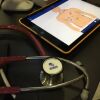Americans have been putting on weight in the past 30 years. So too have many EMS providers. This has created a near perfect storm.
The patients are getting heavier while in general, the EMS workforce has gotten both older and heavier. One reason this has not already resulted in widespread crisis is better technology for moving them.
The first mitigation technology for obesity was the pneumatic lift gate. The first of these I ever saw was on a Community Ambulance truck in Kansas City, Mo., back in the early 80s.
It could not fold under or be removed. So, the lift platform stood straight out from the back of the ambulance. I once saw it slice a detective’s car down the side on a tight turn.
It looked like the Jolly Green Giant had cut bumper to bumper down the side of the car with a huge hot knife. But it did work, and made loading a far less physical endeavor.
The first practical reactions by EMS were heavier load capacity ambulance stretchers. In the 60s and 70s, the standard load capacity of a cot was 350 pounds.
Today it is nearly twice that. As fast food grew in popularity, so did the size of Americans. By the 80s and early 90s, we began to see a lot more patients weighing more than 350 pounds.
In response to this trend, companies such as Stryker and Ferno began producing cots with a 500-pound load rating. Today both companies manufacture cots with a 650-750 load capacity, and powered cots with up to a 1,000-pound load rating or more. Stryker’s MX-Pro Bariatric Transport Stretcher is rated to an astounding 1,600-pound capacity.
Ferno offers a range of clever accessories to convert their standard stretchers into bariatric models. The LBS Bariatric Board increases the surface of a stretcher to accommodate the obese patient.
Even their Mortuary Cots have had to increase load capacity. The Ferno 24MiniMAX can carry 1,000 pounds.
Then, long spine boards got wider and able to carry heavier loads. Today we have a number of high load capacity models to choose from. The Prolite XT-18 has a 1,000-pound capacity and so does the Wide Sports Board and the MAXI-WIDE from EP&R.
In addition, portable stretchers have become much stronger. Examples include the Reeves Heavy-Duty Flexible Stretcher and the Hartwell Combicarrier II. Loading systems have also dramatically improved capacity since the earliest lift gates.
The first practical motorized solution was the TranSafe Bariatric Cot Loading System. This system consists of a folding ramp system that can be deployed inside the ambulance and a high-capacity removable winch. It allows controlled loading of up to a 1,300-pound patient.
More recently introduced is the MAC’s Ambulance Lift. It can also lift up to 1,300 pounds. Unlike the earliest lift systems, this one has a platform that stores under the floor, leaving the ambulance interior unobstructed.
Lateral transfer devices have also evolved to cope with these increasing loads. The first was the old sheet transfer. Then we got the Beasy Trans and heavy duty MANTA Rescue Aid.
Specially designed soft transfer devices and slide boards became commonplace in hospitals, but for one reason or another few turned into big EMS products. I have seen three new transfer technologies that may change all that.
The Stryker Speed-Sheet is an innovative disposable transfer assist that reduces friction. It not only makes transfers side-to-side easier, it also acts as a barrier, keeping your cot clean. Last, it is the most convenient to use and compact to store. These attributes are probably going to make it a hot item in EMS.
The SallyRoller is a clever slide board with disposable covers. It is a combination lightweight folding slide-board and transfer sheet in one product. But what happens when you must move an obese patient more than a few inches, without your cot?
The third promising solution is the HoverMatt from HoverTech. It works just like a floating hovercraft. The air pump inflates the mattress and allows you to slide the patient on a cushion of air. Their disposable version is available in three different widths and is both radiolucent and MRI compatible.
Another product I have seen lately is the BEAR or Bariatric Equalizing Abdominal Restraint. It holds patient adipose tissue more in the midline to stabilize a large abdominal mass, and you can read more about the product in an earlier EMS1 article.
There is really only two parts of this problem that EMS professionals can control personally. One part is your physical condition. Frankly, I don’t see too many obese or emaciated furniture movers.
We have to remember that at its core, our mission is to move people. That is why it is called Care & Transportation of the Sick and Injured. We have to move these folks to the ambulance and drive them to the hospital.
We are public safety athletes, and need to start seeing ourselves that way. Brian Fass touches on real fitness solutions frequently in his excellent EMS1.com column.
The second solution is better training. I don’t think we get enough qualified instruction on how to lift or move these patients properly. Lifting and moving the obese is still mostly done the same way we move average weight patients. We really need a different set of skills to do this job safely.
For example, most patients are moved around on stretchers in the upright position. This is downright dangerous with an obese patient. A few more tips are described in the Ferno guide to Bariatric Patient Handling.
We have an enormous challenge. Transportation of the obese will soon become a daily problem that we must confront with better technology and techniques. We need to move these difficult patients safely. By safely, I mean without injury to either the patient or the EMS provider.












